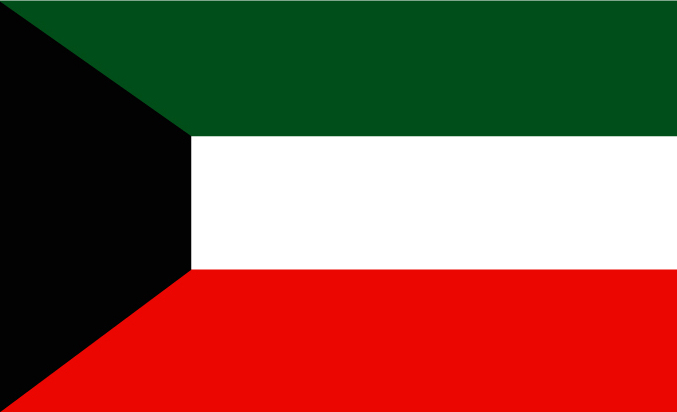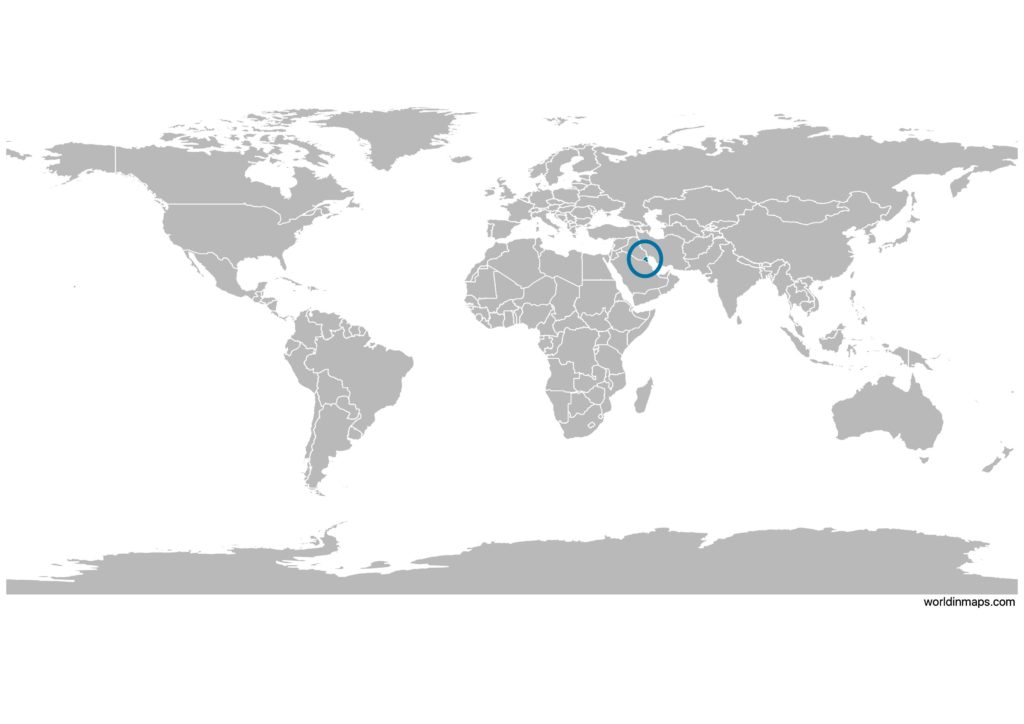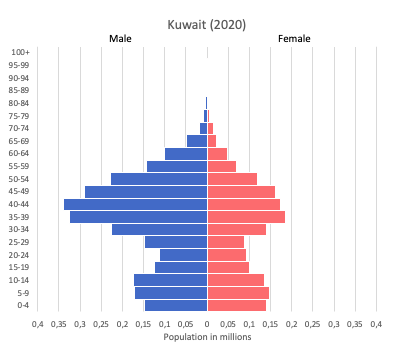Kuwait

| Government | |
| Name | State of Kuwait |
| Arabic | دولة الكويت Dawlat al-Kuwait |
| Government type | constitutional monarchy (emirate) |
| Capital | Kuwait City (3.115 million(urban area – 2020)) |
| Currency | Kuwaiti dinar (KWD) |
| People | |
| Population (2020) | 4,270,563 (127th) |
| Density of population | 200.2 P/km2 (61st) |
| Nationality | Kuwaiti |
| Official languages | |
| Arabic | |
| Ethnic groups (2018) | |
| Kuwaiti | 30.4% |
| other Arab | 27.4% |
| Asian | 40.3% |
| African | 1% |
| other | .9% |
| Religions (2013) | |
| Muslim (official) | 74.6% |
| Christian | 18.2% |
| other and unspecified | 7.2% |
| note: data represent the total population( about 69% of the population consists of immigrants) | |
| Life expectancy (2020) | |
| Male | 77.2 years |
| Female | 80.2 years |
| Total population | 78.6 years (65th) |
| Homicides | |
| Total (2012) | 1.8 per 100,000 people (109th) |
| Geography | |
| Land area | 17,818 km2 |
| water area | 0 km2 |
| total area | 17,818 km2 (158th) |
| Mean elevation | 108 m |
| Lowest point | |
| Persian Gulf | 0 m |
| Highest point | |
| Unnamed | 300 m |
| Land use (2011) | |
| Agricultural land | 8.5% |
| Arable land | 0.6% |
| Permanent crops | 0.3% |
| Permanent pasture | 7.6% |
| Forest | 0.4% |
| Other | 91.1% |
| Urbanization | |
| Urban population (2020) | 100% |
| Rate of urbanization | 1.78% annual rate of change (2015 – 2020) |
| Economy | |
| Labor force (2017) | 2.695 million (112th) |
| note: non-Kuwaitis represent about 60% of the labor force | |
| Labor force by occupation | |
| Agriculture | NA |
| Industry | NA |
| Services | NA |
| Unemployment rate (2017) | 1.1% (11th) |
| GDP (PPP) (estimate 2020) | |
| Total | $303 billion (57th) |
| Per capita | $67,891 (8th) |
| GDP (nominal) (estimate 2020) | |
| Total | $118.271 billion (57rd) |
| Per capita | $28,199 (23rd) |
| GDP by sector (estimate 2017) | |
| Agriculture | 0.4% |
| Industry | 58.7% |
| Services | 40.9% |
| Exports (2017) | $55.17 billion (50th) |
| Exports partners (2017) | |
| South Korea | 18.3% |
| China | 17.4% |
| Japan | 11.5% |
| India | 11.2% |
| Singapore | 6.3% |
| US | 5.7% |
| Imports (2017) | $29.53 billion (69th) |
| Imports partners (2017) | |
| China | 13.5% |
| US | 13.3% |
| UAE | 9.5% |
| Saudi Arabia | 5.8% |
| Germany | 5.4% |
| Japan | 5% |
| India | 4.7% |
| Italy | 4.5% |
Kuwait on the world map

Kuwait is located in Asia and more specifically in the Middle East.
Demography
Population pyramid

Age structure data
Estimate for 2020:
- 0-14 years: 24.29% (male 378,778/female 348,512)
- 15-24 years: 14.96% (male 245,354/female 202,642)
- 25-54 years: 52.39% (male 984,813/female 583,632)
- 55-64 years: 5.43% (male 90,583/female 72,026)
- 65 years and over: 2.92% (male 38,614/female 48,752)
Remark: the age structure of a population affects a nation’s key socioeconomic issues. Countries with young populations (high percentage under age 15) need to invest more in schools, while countries with older populations (high percentage ages 65 and over) need to invest more in the health sector. The age structure can also be used to help predict potential political issues. For example, the rapid growth of a young adult population unable to find employment can lead to unrest.
Population from 1950 to 2020
Source: United Nations, Department of Economic and Social Affairs, Population Division (2019). World Population Prospects 2019, Online Edition. Rev. 1.
Evolution of the life expectancy from 1960 to 2018
Source: World Development Indicators, The World Bank
Economy
Agriculture:
fish
Industries:
petroleum, petrochemicals, cement, shipbuilding and repair, water desalination, food processing, construction materials
Exports – commodities:
oil and refined products, fertilizers
Imports – commodities:
food, construction materials, vehicles and parts, clothing
Time zone and current time in Kuwait
Go to our interactive map to get the current time in Kuwait